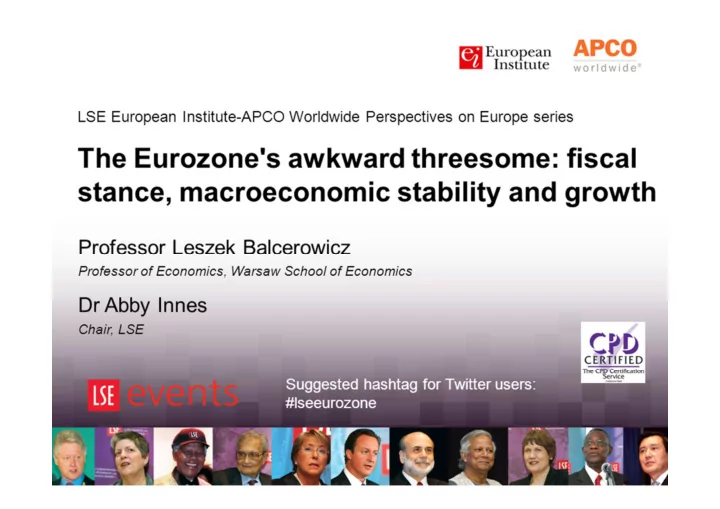

LSE European Institute-APCO Worldwide Perspectives on Europe series The Eurozone's awkward threesome: fiscal stance, macroeconomic stability and growth Professor Leszek Balcerowicz Professor of Economics, Warsaw School of Economics Dr Abby Innes Chair, LSE Suggested hashtag for Twitter users: #lseeurozone
2 ����������������������������� ������������������ ������������������ Warsaw�School�of�Economics� London�School of�Economics 8th�May,�2012� * I am grateful to Magda Ci Ŝ kowicz, Andrzej Rzo ń ca, Aleksander Łaszek, Marcin Brycz, Andrzej J ę drzejowicz, Marek Radzikowski, Lech Kalina for the assistance in preparing this presentation.
3 �������� I. Fiscal�Stance�(the�State�of�the�Public�Finance) II. Public�Finance�as�a�Systematic�Brake�on�Growth III. Crises�(which�include�the�Fiscal�Distress) IV. The�Follow+up�to�the�Financial+Fiscal�Crises:�the� Experience V. The�Central�Banks,�Public�Debt,�Inflation VI. The�Fiscal�Consolidation/Reforms VII. What�are�the�Structural�Problems�in�the�Euro+area?� What�are�the�Solutions? VIII. The�Necessary�Reforms
4 I.�Fiscal�stance�(the�state�of�the�Public� Finance)
5 I.1�Conventional�Measures Spending������������������Taxes�������������������Deficit�(surplus)�������������������Explicit�Public�Debt Spending�is�the�key�driver;�especially�the�social�transfers Figure�1.�General�government�spending�as�%�of�GDP ���� ���� ���� ���� ���� ���� ���� ���� 17,0 27,6 29,0 34,6 46,1 49,8 51,6 52,3 France 14,8 25,0 34,1 32,4 47,9 45,1 45,1 43,6 Germany 17,1 30,1 31,1 30,1 42,1 53,4 46,2 47,9 Italy 12,7 26,2 30,0 32,2 43,0 39,9 39,0 44,2 UK USA 7,5 12,1 19,7 27,0 31,4 32,8 34,5 36,6 Source:�Tanzi�V.,��Schuknecht�L.�(2000),�Public�spending�in�20th�century,�Cambridge�University�Press�;�World�Economic�Database Figure�2.�Social�spending�(in+kind�and�in+cash�spending)�as�%�of�GDP ���� ���� ���� ���� ���� ���� ���� ���� 1,2 3,7 13,7 26,1 29,3 32,0 32,0 France 21,1 30,4 27,6 31,8 28,9 Germany 2,2 3,3 16,4 25,4 28,4 29,6 31,5* Italy 7,1 10,5 15,3 22,9 24,7 26,3 29,9 UK USA 8,6 9,7 18,1 18,4 19,6 21,4 Source:�Master�theses�on�welfare�state�dynamics�by:�Magda�Ciżkowicz,�Jarosław�Kantorowicz,Piotr�Pękała,�Wiktor�Rak�,�Seweryn�Szwarocki
6 ������������������������������������������������������������������������������������� ������������������������������������ 1.1 Explicit liabilities (debt) 2. 1�Government assets 1.2�Implicit liabilites (legislative vs. 2.2 Future taxes promises,�mainly welfare entitelments) Aging �������������� ��� ��������� ��������� ����� �� ������� ��������� ������� ��� ������� ����� �������� ������������ ����������� What are the options (good and�bad): 1.�Privatise the state�assets to�reduce the explicit public�debt 2.�Introduce reforms which would: Reduce implicit liabilites (reforms of�the welfare state) • Strenghten the economic growth • 3.�Increasing taxes – counterproductive as�tax/GDP�ratios are already at the high�levels and� further substantial increases would hurt�growth 4.�Reduce the explicit liabilities: In�a�explicit way (debt restructuring) • In�a�hidden way (inflation)+ can apply only to�the debt denominated in a�country’s currency •
7 �� ��!���!��������"���#������$����� 1. Public�Finance�as�a�Systematic�Brake�on� Growth 2. Public�Finance�as�a�Source�of�Growth� Breakdowns�(crises)
8 II.�Public�Finance�as�a�Systematic�Brake�on� Growth�(the�effects�of�a�large�and�badly� structured�Welfare�State+WS)
9 The effects of the Welfare State Ews = E (WS; E) • As the WS is a complex institutional variable, the effects depend on the state of this variable i.e. the size and structure of the WS. Remember the structure influences the size. • Effects also depend on the environment, in which the WS operates e.g. the Danish model transferred into the US would produce much higher unemployment than in Denmark because of faster growth of labour supply in the US. Models should be compared for the same conditions. • Four mechanisms related to large and badly structured WS: 1) distorting the individual’s incentives and, as a result, behavior (e.g.propensity to work, to search for a job, to save); 2) the distorted behavior leads to a reduction in the capacity to work (hysteresis); 3) massively distorted behavior - change in the social norms (e.g. the work ethics, the cohesion of the family); (Lindbeck, A., 2003) 4) the expansion of the WS crowds out actual or potential forms of non-state social assistance and of mutual aid (see later). • As a result of crowding out, larger WS are accompanied by smaller doses of non-state mechanisms (both of market and of non-market type) than smaller WS. Effects of larger WS include these displacement effects.
10 Figure 3. The analytical scheme Growing social • Slower growth of the transfers standard of living Fiscal position Reduced rate of of the state economic growth • Weaker international position Increasing taxation Expansion of „social” • Poverty regulations: The rise in long-term • Social exclusion • Excessive job protection unemployment • Excessively high • Intergenerational minimum wage (France) effects
11 Other consequences of large and badly structured Welfare States • Increasing inequalities 1) The victims of the average high structural unemployment are young people and women (OECD). 2) Strong job protection produces the division into privileged “insiders” and discriminated “outsiders”; dual labour market. 3) Social transfers in many countries, especially of the Third World, are regressive. • The misuse of social transfers – Sweden: sickness benefits: 1955: 12 days/person/year 2001: 32 days/person/year – Germany - “Sozialbetrug” • Strong tax progression – Weakening the incentives to work more. – Stimulating the growth of the second economy and/or weakening the division of work in society (expensive services).
12 Expansion of the Welfare State has crowded out the actual or potential forms of non-state social assistance and mutual aid • Britain – friendly societies (mutual aid associations) 1877: 2.8 million members 1897: 4.8 million members 1910: 6.6 million members – strong crowding out since 1948 (Green, P., 1988) – spending on education 1833: 1% national income 1920: 0.7% national income (West, E., 1991) • The US -the reduction in public social spending at the end of 19th century has been accompanied by the increase in the non-state arrangements. -1 percentage increase in per capita federal social spending on education, health care and public assistance in years 1950-1970, led to reduction of private charitable contributions by 0,28 percent (Roberts, R.D. , 1984). - public assistance transfers, unemployment insurace benefits, workers compensation payments, as well as social insurance benefits crowd out private interhousehold transfers of money and time (Lam, D., Schoeni, R., 1993).
Recommend
More recommend